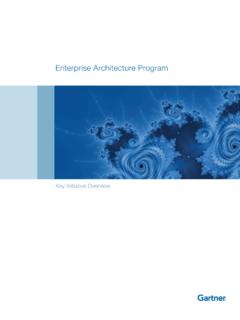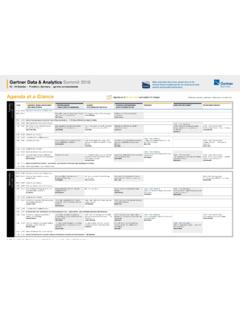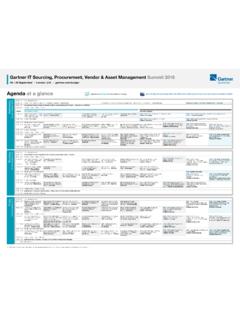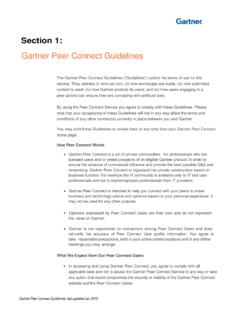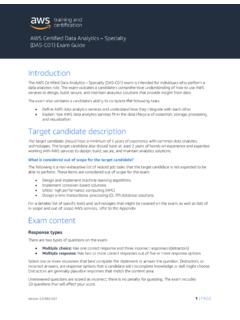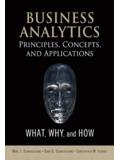Transcription of Gartner's Business Analytics Framework
1 G00219420 Gartner's Business Analytics FrameworkPublished: 20 September 2011 Analyst(s): Neil Chandler, Bill Hostmann, Nigel Rayner, Gareth HerschelThis Framework defines the people, processes and platforms that need tobe integrated and aligned to take a more strategic approach to businessintelligence (BI), Analytics and performance management (PM) Findings Enterprises will increasingly use a combination of products and services to support the diversityof Analytics and decision-making process within their enterprise. Interested Business leaders recognize the diversity and interrelationships of the analyticprocesses within the enterprise, and can address the needs of varied users without creatingdisconnected silos. A strategic view requires defining decision-making processes and analytical processes, as wellas the processes that define information management, independently from the technology thatwill be used for implementation.
2 Therefore, this Framework clearly identifies the people andprocess pillars, in addition to the platform pillar. The program management, technology and complexity of skills associated with the strategicuse of BI, Analytics and PM increase dramatically as the scope of the initiative widens acrossmultiple Business processes. There is no single or right instantiation of the Framework ; different configurations can besupported by the Framework based on Business objectives and Use this Framework to develop a strategy and an implementation plan, and to surface keydecisions, integration points, gaps, overlaps and biases that Business leaders and programmanagers may not have otherwise prepared for. A portfolio of information management, analytic and decision-making capabilities will be neededto meet the diverse requirements of a large organization. Strike a balance between creatingstandards and allowing a variety of technologies to meet Business needs.
3 If the enterprise has a program management office, seek advice from it on balancinginvestments across multiple projects, and consider bringing BI, Analytics and PM initiativeswithin a formal program management Framework . BI, analytic and PM initiatives are best suited to iterative developments driven by a BIcompetency center (BICC) that gather requirements, prioritize needs and deliver solutions of 2 The Need for a 2 Differences Between the 2011 and 2009 4 Performance: Start With Business Strategy and Enterprise Equal Consideration to People, Processes and Attention to Two Related 13 Program 13 Metadata and 14 Use the Framework to Scope Business Analytics 16 List of FiguresFigure 1. The gartner Business Analytics 3 AnalysisThe Need for a FrameworkThroughout this research, Business Analytics is used as shorthand to represent BI, Analytics andPM.
4 Increased volatility, ongoing economic uncertainty driving first cost-cutting and then return-to-growth strategies and increasing stakeholder pressure has only increased demands from businessexecutives seeking new or better ways to improve performance at all levels of the organization. Thecontinued growth of BI, Analytics and PM with an increasingly large portfolio of availablePage 2 of 18 gartner , Inc. | G00219420solutions with divergent functional capabilities, scale and scope with discrete sponsors and buyingcenters has increased the need for a renewed focus from IT to avoid platform parochialism atbest and analytic anarchy at worst. If unaddressed, BI will continue to be disconnected fromanalytics, and organizations will fail to achieve optimum Business benefits from their program management, technology and complexity of skills associated with the strategic use ofbusiness Analytics increase dramatically as the scope of the initiative widens.
5 No vendor today canprovide all the needed technologies, applications and services, despite megavendors' continuedexpansion through acquisitions. Therefore, enterprises must use a combination of vendors andservices to provide a comprehensive solution. Hence, there is a need for a Framework to be used byIT architects, system developers and program managers that lays out the components in terms ofthe people, processes, platforms and performance that should be aligned as part of a strategicsolution. The Business Analytics Framework shown in Figure 1 updates Gartner's previous BI, Analytics and PM Framework , which we originally published in 2006 and updated in 1. The gartner Business Analytics FrameworkBusiness Models, Business Strategy and Enterprise MetricsInformationProgram ManagementMetadata and ServicesConsumeProduce EnableP e o p l eAnalytic ProcessesInformation GovernanceProcessesDecision ProcessesP r o c e s s e sDecision CapabilitiesCollaboration Decision Making, Intelligent Decision Automation, ApplicationsAnalytic CapabilitiesDescriptive, Diagnostic, Predictive, PrescriptiveInformation Capabilities Describe, Organize, Integrate, Share, Govern, ImplementP l a t f o r m P e r f o r m a n c eSource: gartner (September 2011)Recommended Reading: " Business Intelligence Focus Shifts From Tactical to Strategic Approach" "The BI(G) Discrepancy: Theory and Practice of Business Intelligence" "Deliver Business Intelligence With a 'Think Global Act Local' Organizational Model" gartner , Inc.
6 | G00219420 Page 3 of 18 Differences Between the 2011 and 2009 FrameworksThe updated Framework modifies and extends several areas of the 2009 Framework based onchanges in the scope and scale of client deployments. The main differences are: Terminology: There is confusion concerning the terms BI, Analytics and PM because there is somuch overlap and codependency among them. This report describes their similarities, but alsoemphasizes the specific connotation of each term (see the BI section). BI refers to the generalability to organize, access and analyze information in order to learn and understand thebusiness. This ability can be applied to specific Business processes, decisions and subject areadomains; this is Analytics . Therefore, Analytics can be thought of as applied BI. Note that theterm Analytics is usually preceded by a domain-specific modifier, such as website Analytics orcustomer Analytics .
7 PM applications are a specific type of analytic application that implies thepresence of a management workflow and a goal-setting exercise to define, monitor andoptimize Business objectives. Performance: The performance label is explicitly called out as a banner across the top. This isto reinforce the point that the Framework is composed of people, processes, platforms andperformance aspects. The previous Framework underrepresented the significance of thiscomponent. Likewise, in many organizations, it is the performance aspects that are least matureand most overlooked. People: The updated Framework tweaks the people activities to represent tasks, rather thanroles. Rather than discrete roles for consumer/producer, which best represented the traditionalbusiness-IT relationship, newer forms of Analytics and PM surpass these distinctions. Hence, abusiness Analytics user can easily be involved across produce, consume and enable activities.
8 Information: Information as an underlying foundation has been added to the Framework toreflect the connectivity of and coexistence with all sources of data that Business analyticsutilizes not simply the data warehouse. Since the last Framework , this has expanded toincorporate structured and unstructured data (content), on-premises and cloud-based data, andwe've seen new terms emerge such as "big data" to represent new extreme informationchallenges not only of volume, but also of velocity, variety and complexity of information. Platform: This has seen the biggest number of changes to reflect the continued expansion andlonger-term convergence of BI, Analytics and PM. The previous groupings of Business processapplications, analytic applications and BI platforms represented too narrow a definition of howanalytics and PM continue to grow. Furthermore, these former classifications portrayed aphysical representation of core capabilities that is unlikely to accurately depict next-generationinfrastructures.
9 Consequently, the new classification of the platform aspects of the frameworkare grouped into three clusters of decision-making, analytic and information-centric Reading: "Case Studies for Business Intelligence Excellence Award"Page 4 of 18 gartner , Inc. | G00219420 Performance: Start With Business Strategy and Enterprise MetricsEnterprises should measure the success of Business Analytics programs by how well they help thebusiness achieve strategic objectives. Clearly defined Business strategies and objectives are criticalto the success of any Business Analytics initiative, and to building the case for investment. TheCEO, management team and, typically, a strategy manager at the vice president level manage thecreation and definition of overall corporate goals, strategies and objectives. PM solutions andmethodologies help with strategy development and execution. On the strategy development side,concepts such as performance prisms and balanced scorecards can help interpret strategy, whileapplications such as strategic planning and profitability modeling help finesse planning succeed in executing developed strategy, the enterprise first needs an enterprise metricsframework that links strategic goals with operational activities.
10 Such a Framework minimizes siloed,tactical approaches in which each department or function focuses on its own performance needswithout looking at the bigger picture. This metrics Framework should include defining the cause andeffect relationship between leading and lagging metrics. This definition can take the form of astrategy map or some other Framework that identifies the relationships among different businessmetrics. The metrics Framework will also help create links among different analytic applications,particularly in planning. In many cases, different parts of the organization may create PM initiativesat intermediate levels of the organizational hierarchy. Failure to connect these initiatives will result insuboptimal organizational performance, but may still deliver Business benefits within thoseorganizational groups. Second, the enterprise needs flexible and nimble command and controlcapabilities to closely monitor the chosen strategy and support, where necessary, fact-baseddecision making to find suitable modifications or also signifies that this Framework can be applied at a global or local level.
